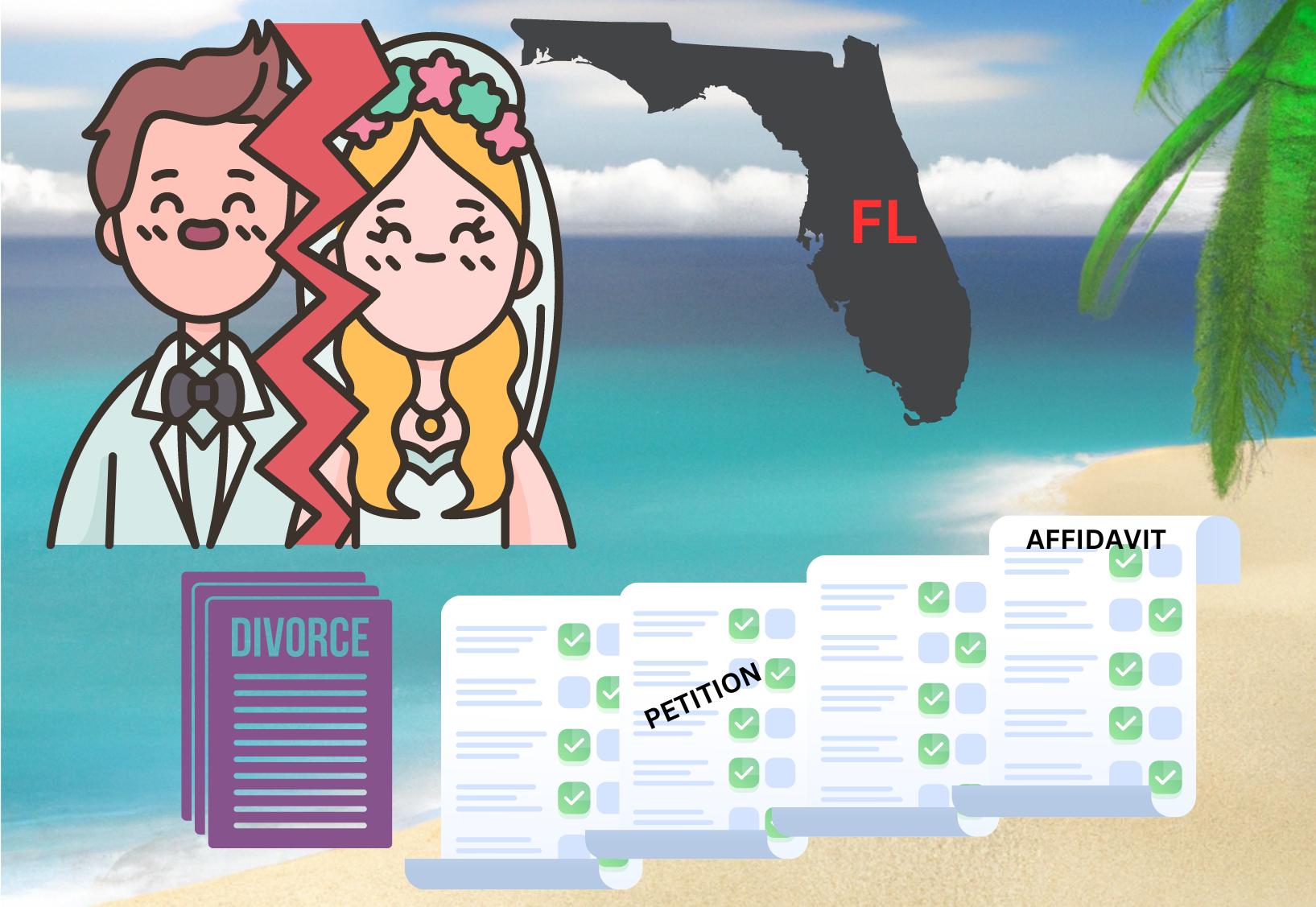I was not an exception either.
When I filed for a divorce a few years ago, I trusted my lawyer and, without hesitation, followed his lead. I wish I had known the divorce language, dissolution of marriage forms, and the proper sequence of the events. It would have saved me money and helped to avoid costly mistakes.
Today, as a Certified Divorce Financial Analyst®, I know that no matter if you work with an attorney, it pays to understand how the divorce process works.
In this post, I will demystify the topic of the essential Florida divorce forms and cover the most common mistakes you should avoid.
So, let's dive in...
Florida Divorce Forms: Initial Filing
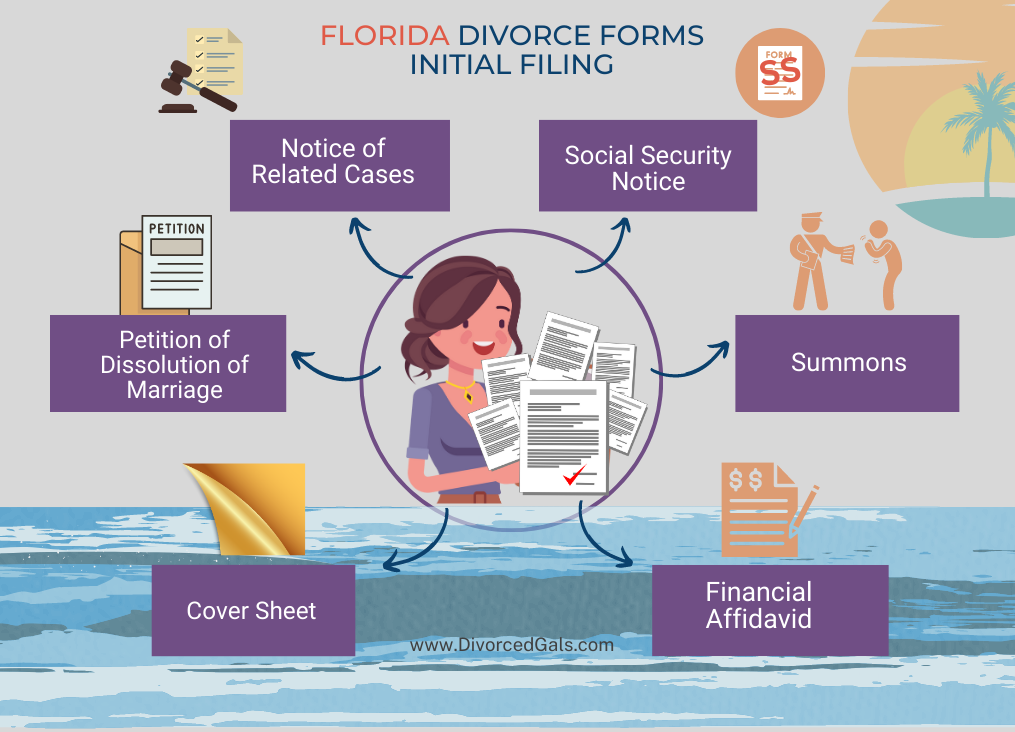
First, before filing for a divorce in Florida, you should meet the residence and grounds for divorce requirements:
Residence:
- One spouse should reside 6 months in Florida before filing for divorce.
Grounds for Divorce:
- Marriage is irretrievably broken;
- Mental incapacity of one of the parties determined by the court
Next, you can start initial filing, the second step in the Florida divorce process.
Below are mandatory Florida divorce forms.
1. COVER SHEET - Form 12.928
The Cover Sheet addresses the following:
- Case style (circuit court, county, case number, judge, petitioner, respondent)
- Type of action (initial action, reopening case, or modification)
- Type of case
2. PETITION FOR DISSOLUTION OF MARRIAGE
On the Florida Courts website, there are four Petition for Dissolution of Marriage forms depending if you have minor children or property:
- Petition for Dissolution of Marriage Florida Form 12.901(b)(1)
- Petition for Dissolution of Marriage with No Dependent or Minor Child or Property Florida Form 12.901(b)(3)
- Petition for Dissolution of Marriage with Property but No Dependent or Minor Child Florida Form 12.901(b)(2)
- Petition for Simplified Dissolution of Marriage Florida Form 12.901(a)
In general, the Petition covers the following:
- Residence of the parties
- If either of them is a member of the military
- Marriage history
- Are there minor children?
- Are you asking for child support?
- Parenting responsibility and time-sharing
- Are you asking for alimony?
- Marital assets and liabilities
3. NOTICE OF RELATED CASES - Form 12.900(h)
The court wants to know if you have any related court cases with a person you want to divorce, for example:
- You are already separated and filed for child support
- Pending bankruptcy case
- Domestic violence injunction
- Adoption/Paternity
4. NOTICE OF SOCIAL SECURITY NUMBER - Form 12.902(j)
This form collects statistical data, and the court keeps it CONFIDENTIAL.
5. SUMMONS - Form 12.910(A)
You fill out this form and will serve the other party. You let them know that you are suing the other party and what the next steps are.
6. FINANCIAL AFFIDAVIT - Form 12.902(B), Form 12.902(C)
To get a divorce in Florida, you must exchange all your financial information in the Financial Affidavit with the other party and give some basic information to the court to calculate child support and alimony if needed.
PRO TIP 1: Gather and organize your financial information before completing the Financial Affidavit and maintain copies of supporting document.

If you file for a divorce without an attorney, check below a video training on how to file a new case on Florida Courts E-Filing Portal.
Local Forms
In addition to the Florida Supreme Court divorce forms, different counties might have local divorce forms.
PRO TIP 2: Review divorce forms online provided by Florida Courts and understand their specific purpose and requirements.
PRO TIP 3: Be thorough: incomplete or inaccurate forms may result in delays or cause red flags.
Simplified Dissolution of Marriage Form
Are you and your spouse amicable?
If yes, you might have an uncontested divorce. Here, you serve the other party; they respond, agree to all terms, and want to participate.
Further, you can choose a Simplified Divorce and use a Simplified Dissolution of Marriage Form.
Briefly, a Simplified Divorce is a divorce process that requires:
- Six-month Florida residency for one of the spouses
- No children
- No pregnancy
- No alimony
- Agreement – both parties must sign the petition and appear at the final hearing
Simplified Divorce Case Study
Let's look at Mike and Sarah.
They have been married for three years and mutually decided to end their marriage. They wanted to streamline their Florida divorce process and avoid the complexities of a regular divorce.
Mike and Sarah meet the eligibility requirements above and should follow the steps of a Florida divorce process:
1. Petition Filing:
- Mike and Sarah complete basic Florida divorce forms and provide their personal information, marriage details, and how they want to divide assets and debts.
2. Serving the Petition:
- Sarah files forms with the family court in the county where they reside.
- She serves the petition to Mike by certified mail with a return receipt.
3. Waiting for Response:
- Mike reviews the petition, agrees with all terms, and signs an acknowledgment of receipt form.
- He indicates that he agrees to go with the simplified dissolution of marriage.
4. Final Hearing:
- The court sets a final hearing, and Mike and Sarah appear together before a judge.
- The judge reviews the petition to ensure that spouses understand the terms of the agreement.
5. Final Judgment:
- If the judge approves, the court issues a final judgment of simplified dissolution of marriage.
Now, Mike and Sarah are legally divorced!
PRO TIP 4: Simplified divorce is NOT APPEALABLE!
Are You and Your Spouse Amicable?
Contact us if you have more complex finances!

Next, do you have minor children?
Filing for Divorce in Florida with Child
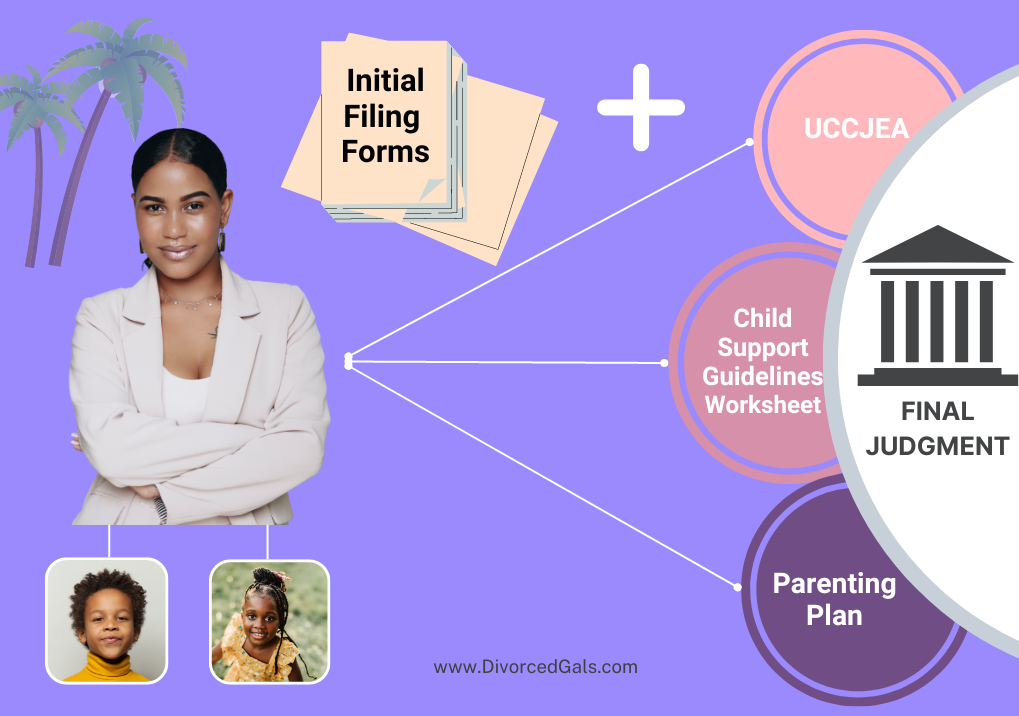
7. UCCJEA – Uniform Child Custody Jurisdiction and Enforcement Act Affidavit - Form 12.902(D)

The UCCJEA is about any court cases related to minor children in your case (either in another state or county). It also asks where children have lived for the last 5 years.
8. CHILD SUPPORT GUIDELINES WORKSHEET - Form 12.902(E)
Florida divorce child support guidelines FS 61.30 determined what child support should be. It is a set number based on the parents' combined income and the number of children.
These are only general guidelines, and the court will also look at other factors:
- child's health insurance premium
- work-related childcare expense
- how much time parents spend with a minor
You can use this Florida child support calculator to get an estimate.
9. PARENTING PLAN - Form 12.995(a)
Here, you detail what parental responsibility, and timesharing should be.
PRO TIP 5: You should only file the UCCJEA to initiate the case and file the other two forms later if you are still deciding or think you might reach an agreement with your spouse.
Asking for a Child Support: What You Should Know
You ask for child support in a petition, as well as who should provide health insurance, how parents should split uninsurable medical expenses, and address other issues.
But what if both spouses agree not to ask for child support?
The court still MUST address what child support would be.
Why?
Technically, child support belongs to a child. Parents can set it to a zero or "reserve" it but never waive it.
PRO TIP 6: If circumstances change, parents can modify child support before a minor reaches 18.
Not sure where to start?

Respondent Answer
10. RESPONDEnt ANSWER
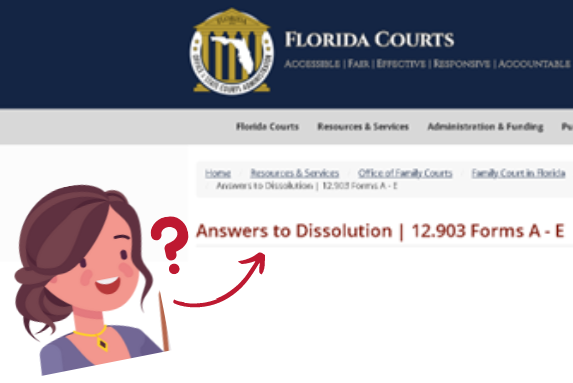
The next step in your Florida divorce process is to serve the other party.
Then, there is a 20-day waiting period, and you decide what to do next unless a party responds earlier.
Like a petition, there are different versions of Answers to Dissolution if you have dependent or minor children and have property together or not.
The Answer mirrors a Petition and asks whether you admit what the petitioner is saying, deny what, or if you might need additional information.
In the Answer, the respondent certifies when a response was delivered to a petitioner and a form of delivery:
- fax
- hand delivery
Along with the Answer, a respondent should file a completed Florida Financial Affidavit or indicate that it will be timely filed. Also, the respondent should indicate when they delivered an affidavit to the other party.
A respondent can also use the Answer in Waiver form, saying, "I agree with everything and waive notice for a final hearing. Just send me a copy of the final divorce in the mail."
PRO TIP 7: You can CONTEST something in the "Answer." In an "Answer in Waiver," – you agree with everything and CANNOT CONTEST the final judgment.
PRO TIP 8: An "Affidavit of Military Service" is required in every case where the Respondent has not filed an answer or appearance.
But wait! There is more...
Final Judgment of Dissolution of Marriage

The final step before you can say, "I am divorced!" is a Final Judgment of Dissolution of Marriage. It is a legally binding document issued by the family court and officially terminates your marriage.
The final judgment has significant consequences.
Regardless, if you have an attorney or filed for a divorce without an attorney, be aware of the 7 critical elements of the Final Judgment of Dissolution of Marriage:
1.
Identification of Parties:
It includes spouses' legal names and any known aliases.
2.
Termination of Marriage:
The final judgment indicates the ending of the spouses' marital relationship.
3.
Division of Property and Debts:
This section outlines the agreed-upon terms, such as the allocation of real estate, financial accounts, personal property, and marital debts.
4.
Alimony (Spousal Support):
The judgment may state the amount, terms, and duration if there is alimony. However, in a simplified divorce, the dissolution generally says neither party is asking for alimony.
5.
Child Custody and Support:
If there are dependent or minor children, the final judgment of marriage dissolution addresses timesharing, visitation rights, and child support. Also, it outlines the parenting plan and any additional financial obligations related to a child's well-being.
6.
Name Change (If applicable):
If you or your spouse requested a name change as part of a divorce, the final judgment may include the approved name change.
7.
Other Provisions:
Here, it might include any additional provisions related to your divorce.
- restraining order
- return of personal property
- any other specific agreements
PRO TIP 9: You and your spouse should carefully review the Final Judgment of Dissolution of Marriage to ensure that it accurately reflects your marital settlement agreement and protect your rights and interests.
Register to receive our divorce MONEY TIPS!
One more thing...
Common Mistakes When Completing Florida Divorce Forms
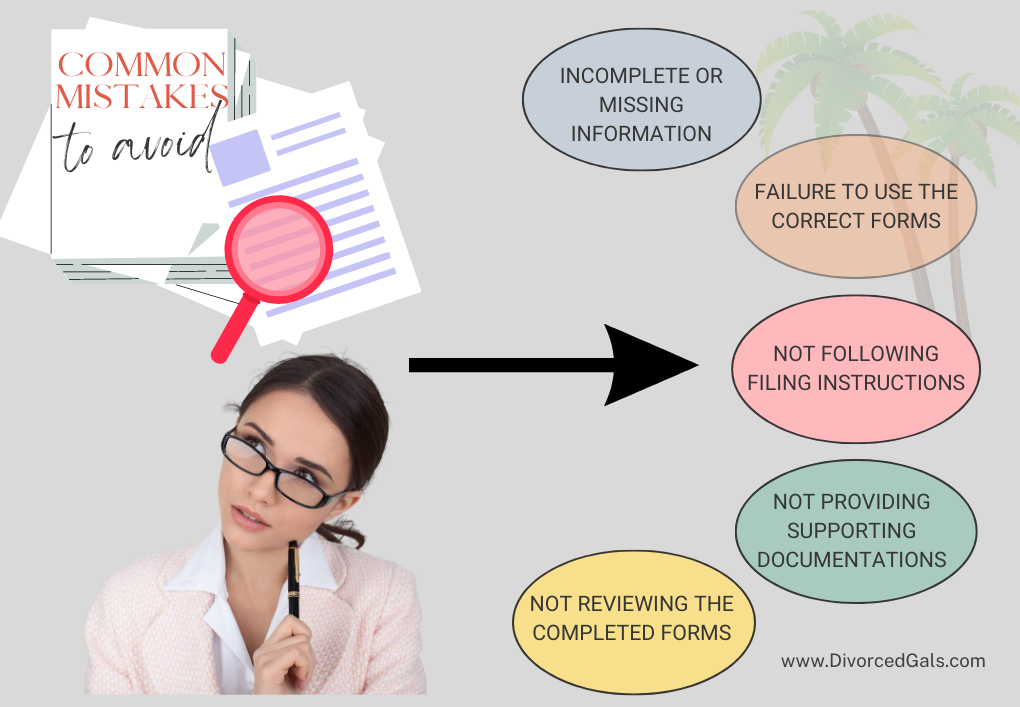
Want to avoid complications and lengthy court proceedings?
I must warn you about the most common mistakes I see when I help my clients as a divorce financial expert, especially in Financial Affidavits. It can delay your divorce or lead to undesirable outcomes.
1. INCOMPLETE OR MISSING INFORMATION:
Failure to provide all the necessary information in the Florida divorce forms can lead to delays or rejection. Read carefully and complete each section.
2. INCORRECT OR INCONSISTENT INFORMATION:
Ensure your information is identical in different sections of your Florida divorce forms. Otherwise, it might lead to red flags and further complications.
3. FAILURE TO FOLLOW FILING INSTRUCTIONS:
Please be sure you precisely follow the specific formatting of the divorce forms. Also, you should pay attention to instructions regarding font size, margins, signatures, and filing deadlines.
4. NOT PROVIDING REQUIRED DOCUMENTS:
Some Florida divorce forms may require supporting documentation, such as financial statements, parenting plans, or property inventories. Please include everything needed to ensure the progress of your divorce case.
5. NOT REVIEWING THE COMPLETED FORMS:
Before submitting your Florida divorce forms, thoroughly review them for mistakes or omissions.
6. FAILURE TO USE THE CORRECT FORMS:
Are you using the up-to-date Florida divorce forms? Use the Florida courts website or consult an attorney. For local forms, check your county clerk's website.
7 IGNORING THE NEED FOR PROFESSIONAL ADVICE:
Yes, you can complete your Florida divorce forms without legal assistance. However, an attorney can guide and ensure your rights and interests if you have a more complex case.
PRO TIP 10: While completing Florida divorce forms, consider the future. It is crucial to think about the long-term implications of the decisions you make today.
Pre-Divorce Checklist PDF: 7 Sure Steps for Better Divorce
FAQs: Frequently Asked Questions
The easiest way to get a divorce in Florida is through an uncontested divorce:
- both spouses agree on all the major issues (child support, division of assets and debts, and alimony if applicable.)
You can get Florida divorce forms online. Check the Florida Courts website and at the office or on the website of your county Clerk of the Circuit Court & Comptroller.
You can file the completed Florida divorce forms at the local clerk's office at the nearest courthouse, or online through the E-Filing Portal.
In the state of Florida, the cost to file for a divorce without an attorney can vary depending on several factors, including:
- county where you file
- the complexity of the case
Filing/Service of Process Fees
For example, to initiate a divorce in Palm Beach County is $409.00. The same fee is also in some other counties. The Clerk of Court will also charge $10.00 to issue the summons so that a licensed process server or a deputy will serve the opposing party. The Clerk of the Circuit Court & Comptroller also charges a $5 statutory fee for paying the filing fees electronically.
Professional Fees
Suppose you hire an attorney or other professionals -- Certified Divorce Financial Analyst®, CPA, or others to handle your divorce case. Their fees can vary widely based on their experience, reputation, and the complexity of your case.
Additional Costs
Depending on your specific situation, there might be extra costs:
- fees for mediation
- court-ordered parenting classes
- expert witness fees (if needed)
- any other services or requirements unique to your case
In this case, the petitioner can ask for a Clerk's Default. It simply means that a responding party has defaulted by not participating in the case. The court will review your case to ensure you meet all the requirements and serve the other party properly.
If everything is in order, the court may enter a default judgment in favor of a petitioner. The default judgment can address various issues, such as property division, child custody, child support, and alimony, depending on the nature of the case.
You should know that the specific procedures and requirements for obtaining a Clerk's Default may vary depending on the type of case and the local court rules.
Before you complete your Florida divorce forms, know that Florida is a no-fault state, so you don’t have to prove any wrongdoing. According to Florida divorce laws, you should meet one of the following requirements:
- Marriage is irretrievably broken
- Mental incapacity of one of the parties (determined by the court)
Yes, one party should reside 6 months in the state before filing the petition.
In Summary...
I hope I helped you to demystify the topic of essential Florida divorce forms. Of course, your specific situation might require additional paperwork and administrative steps. Use this article as a reference.
Remember my friend Marsha?
She messed up her Florida divorce forms and needed an attorney to get her back on track and navigate her divorce process.
Remember that you might not only have your divorce delayed or paperwork rejected. You also can face the legal consequences, never mind more stress, time, and money.
Is it worth it?
So, be smart and don't repeat Marsha's mistakes.
If you file for a divorce, treat it as a serious business. At a minimum, study the essential Florida divorce forms. But remember that in a divorce, YOU ONLY HAVE ONE CHANCE TO GET IT RIGHT!
What Are You Waiting For?
Start CONTROLLING Your Money!
Looking out for you,
Nella Zelensky
About the Author

